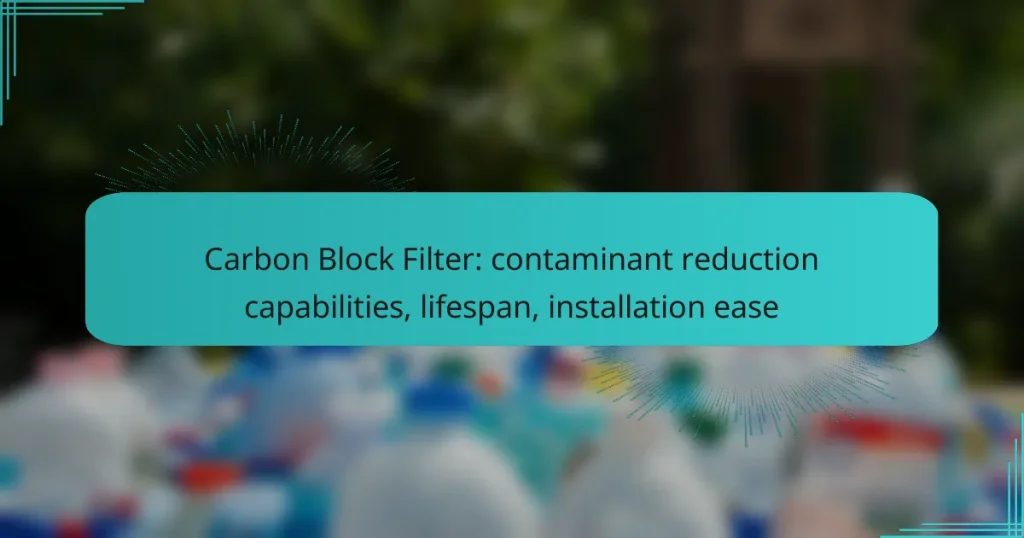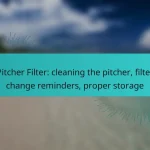Carbon block filters are highly effective in reducing various contaminants in water, such as chlorine, heavy metals, and organic compounds, enhancing both quality and taste. With a lifespan of 6 to 12 months, regular maintenance is crucial for optimal performance. Additionally, these filters are designed for easy installation, often allowing users to set them up in under an hour with minimal tools required.

What are the contaminant reduction capabilities of carbon block filters?
Carbon block filters are effective at reducing a wide range of contaminants in water, including chlorine, heavy metals, and organic compounds. Their design allows for a high surface area that captures impurities while improving water quality and taste.
Chlorine removal
Carbon block filters excel in removing chlorine from drinking water, which is commonly used as a disinfectant in municipal supplies. The activated carbon in these filters adsorbs chlorine molecules, significantly reducing their concentration and improving the overall taste and safety of the water.
Typically, these filters can reduce chlorine levels by over 90%, making them a popular choice for households concerned about chemical exposure.
Heavy metal reduction
These filters can also effectively reduce heavy metals such as lead, mercury, and cadmium. The carbon’s porous structure traps these contaminants, preventing them from passing through the filter and into the drinking water.
While the reduction rates can vary, many carbon block filters are certified to remove a significant percentage of these harmful metals, contributing to safer drinking water.
Microbial contamination control
Carbon block filters can help control microbial contaminants, including bacteria and viruses, through a combination of adsorption and size exclusion. The dense structure of the carbon block can physically block larger pathogens while also adsorbing some smaller ones.
However, it’s important to note that not all carbon block filters are designed to eliminate all types of microorganisms, so checking for specific certifications is advisable.
Organic compound filtration
These filters are particularly effective against organic compounds, such as pesticides and volatile organic compounds (VOCs). The activated carbon’s high surface area allows it to adsorb these substances, thereby reducing their presence in drinking water.
Many carbon block filters can achieve substantial reductions in organic contaminants, making them a reliable choice for improving water quality.
Improved taste and odor
One of the most noticeable benefits of using carbon block filters is the improvement in taste and odor of water. By removing chlorine, organic compounds, and other impurities, these filters enhance the overall sensory experience of drinking water.
Users often report a fresher, cleaner taste, which encourages higher water consumption and promotes better hydration.

How long do carbon block filters last?
Carbon block filters typically last between 6 to 12 months, depending on usage and water quality. Regular maintenance and timely replacement are essential to ensure optimal contaminant reduction capabilities.
Typical lifespan of 6 to 12 months
The average lifespan of carbon block filters ranges from 6 to 12 months. This duration is influenced by factors such as water usage, the level of contaminants present, and the specific design of the filter. For households with higher water consumption or more contaminants, the lifespan may lean towards the shorter end of this range.
Factors affecting lifespan
Several factors can impact the lifespan of carbon block filters. Water quality plays a significant role; if the water contains high levels of chlorine, sediment, or other impurities, the filter will saturate more quickly. Additionally, the volume of water filtered daily can lead to faster depletion of the filter’s effectiveness.
Other considerations include the specific brand and model of the filter, as some are designed for longer use or higher contaminant loads. Regular monitoring and adherence to manufacturer guidelines can help maximize the filter’s lifespan.
Signs of filter saturation
Identifying signs of filter saturation is crucial for maintaining water quality. Common indicators include a noticeable change in water taste or odor, reduced water flow rate, or discoloration in the filtered water. These symptoms suggest that the filter is no longer effectively removing contaminants.
To ensure optimal performance, it’s advisable to replace the filter once these signs appear, even if it falls within the typical lifespan range. Regular checks can prevent potential health risks associated with using a saturated filter.

How easy is it to install a carbon block filter?
Installing a carbon block filter is generally straightforward and can often be completed in under an hour. Most systems are designed for DIY installation, requiring minimal tools and expertise.
Installation steps overview
To install a carbon block filter, start by turning off the water supply to your system. Next, remove the old filter if applicable, and then install the new carbon block filter according to the manufacturer’s instructions. Finally, restore the water supply and check for leaks.
Ensure that you flush the filter for a few minutes to remove any carbon dust before using the water. This step helps maintain water quality and performance.
Tools required for installation
The tools needed for installing a carbon block filter typically include a wrench, a screwdriver, and possibly a pair of pliers. Depending on your specific setup, you might also need a bucket to catch any residual water during the process.
Having a towel handy can help manage spills and keep the area clean while you work. Make sure to read the installation manual for any additional requirements specific to your filter model.
Professional installation options
If you prefer not to install the carbon block filter yourself, hiring a professional is a viable option. Many plumbing services offer installation for water filtration systems, and costs can vary widely based on location and complexity, typically ranging from $50 to $150.
Before hiring a professional, check their credentials and reviews to ensure quality service. Some retailers may even provide installation services when you purchase the filter, which can simplify the process.

What are the benefits of using carbon block filters in the UK?
Carbon block filters offer significant advantages in contaminant reduction, lifespan, and ease of installation for water purification in the UK. They effectively remove impurities such as chlorine, sediment, and volatile organic compounds, providing cleaner drinking water.
Cost-effectiveness
Carbon block filters are generally affordable, with prices ranging from low tens to low hundreds of pounds depending on the brand and specifications. Their longevity, often lasting several months to a year, reduces the frequency of replacements, making them a cost-effective choice for households.
When considering installation, many carbon block filters are designed for easy setup, often requiring minimal tools or plumbing skills. This simplicity can save on installation costs, allowing users to handle the process themselves.
Environmental impact
Using carbon block filters can significantly reduce plastic waste by minimizing the need for bottled water. By filtering tap water, households contribute to less plastic pollution, aligning with environmental sustainability goals.
Moreover, carbon block filters are often made from natural materials, which can be more environmentally friendly compared to other filtration methods. Choosing these filters supports a more sustainable approach to water purification.
Health benefits
Carbon block filters improve water quality by effectively removing harmful contaminants, which can lead to better health outcomes. By filtering out chlorine and other chemicals, they enhance the taste and odor of drinking water, encouraging increased hydration.
Regular use of carbon block filters can also reduce exposure to potential health risks associated with contaminants like lead and pesticides. This proactive measure supports overall well-being, particularly for vulnerable populations such as children and the elderly.

What should you consider when choosing a carbon block filter?
When selecting a carbon block filter, consider its contaminant reduction capabilities, lifespan, and ease of installation. These factors will significantly influence the filter’s effectiveness and your overall satisfaction with the water purification process.
Filter certifications
Filter certifications indicate the effectiveness and safety of a carbon block filter. Look for certifications from organizations like NSF International or the Water Quality Association, which ensure the filter meets specific contaminant reduction standards. Common certifications include NSF/ANSI 42 for aesthetic effects and NSF/ANSI 53 for health effects.
Flow rate specifications
Flow rate specifications determine how quickly water passes through the filter, affecting your water supply’s convenience. Typical flow rates for carbon block filters range from 0.5 to 3 gallons per minute (GPM). Choose a filter with a flow rate that meets your household’s needs, especially if you have high water consumption.
Replacement frequency
Replacement frequency is crucial for maintaining filter performance. Most carbon block filters require replacement every 6 to 12 months, depending on usage and water quality. Regularly check the manufacturer’s recommendations and monitor your water’s taste and clarity to determine when it’s time for a replacement.

What are the alternatives to carbon block filters?
Alternatives to carbon block filters include various filtration systems that can effectively reduce contaminants in water. Each option has unique characteristics and may be more suitable depending on specific needs and circumstances.
Reverse osmosis systems
Reverse osmosis (RO) systems utilize a semi-permeable membrane to remove a wide range of contaminants from water. This method is particularly effective for reducing dissolved solids, heavy metals, and certain chemicals, making it a popular choice for households concerned about water quality.
When considering RO systems, it’s important to note that they typically require more maintenance than carbon block filters. The membranes need to be replaced every couple of years, and the system may waste some water during the filtration process. However, the high level of purification can justify these trade-offs for many users.
For optimal performance, ensure the RO system is installed correctly and regularly serviced. Look for systems that meet NSF/ANSI standards for drinking water treatment to ensure reliability and effectiveness.


